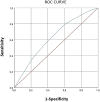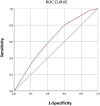Prediction Model with Validation for Polioseronegativity in Malnourished Children from Poliomyelitis Transmission High-Risk Area of the Democratic Republic of the Congo (DRC)
- PMID: 38146546
- PMCID: PMC10749540
- DOI: 10.2147/POR.S437485
Prediction Model with Validation for Polioseronegativity in Malnourished Children from Poliomyelitis Transmission High-Risk Area of the Democratic Republic of the Congo (DRC)
Abstract
Background: Malnutrition is identified as a risk factor for insufficient polio seroconversion in the context of a vaccine-derived poliovirus (VDPV) outbreak-prone region. In the Democratic Republic of Congo (DRC), underweight decreased from 31% (in 2001) to 26% (in 2018). Since 2004, VDPV serotype 2 outbreaks (cVDPV2) have been documented and were geographically limited around the Haut-Lomami and Tanganyika Provinces.
Methods: To develop and validate a predictive model for poliomyelitis vaccine response in malnourished infants, a cross-sectional household study was carried out in the Haut-Lomami and Tanganyika provinces. Healthy children aged 6 to 59 months (n=968) were enrolled from eight health zones (HZ) out of 27, in March 2018. We performed a bivariate and multivariate logistics analysis. Final models were selected using a stepwise Wald method, and variables were selected based on the criterion p < 0.05. The association between nutritional variables, explaining polio seronegativity for the three serotypes, was assessed using the receiver operating characteristic curve (ROC curve).
Results: Factors significantly associated with seronegativity to the three polio serotypes were underweight, non-administration of vitamin A, and the age group of 12 to 59 months. The sensitivity was 10.5%, and its specificity was 96.4% while the positive predictive values (PPV) and negative (PNV) were 62.7% and 65.3%, respectively. We found a convergence of the curves of the initial sample and two split samples. Based on the comparison of the overlapping confidence intervals of the ROC curve, we concluded that our prediction model is valid.
Conclusion: This study proposed the first tool which variables are easy to collect by any health worker in charge of vaccination or in charge of nutrition. It will bring on top, the collaboration between the Immunization and the Nutritional programs in DRC integration policy, and its replicability in other low- and middle-income countries with endemic poliovirus.
Keywords: DRC; child health; child nutrition; malnutrition; polio serotype; poliomyelitis-neutralizing antibodies; prediction model; seronegativity; serotypes; underweight; validation.
© 2023 Mwamba et al.
Conflict of interest statement
The authors declare that they have no conflicts of interest.
Figures



Similar articles
-
Nutritional Status Link with Polioseronegativity Among Children from Poliomyelitis Transmission High-Risk Area of the Democratic Republic of the Congo (DRC).J Multidiscip Healthc. 2024 Mar 19;17:1219-1229. doi: 10.2147/JMDH.S437351. eCollection 2024. J Multidiscip Healthc. 2024. PMID: 38524863 Free PMC article.
-
Vaccine-Derived Poliovirus Outbreaks and Events - Three Provinces, Democratic Republic of the Congo, 2017.MMWR Morb Mortal Wkly Rep. 2018 Mar 16;67(10):300-305. doi: 10.15585/mmwr.mm6710a4. MMWR Morb Mortal Wkly Rep. 2018. PMID: 29543791 Free PMC article.
-
Poliovirus immunity among adults in the Democratic Republic of the Congo: a cross-sectional serosurvey.BMC Infect Dis. 2022 Jan 5;22(1):30. doi: 10.1186/s12879-021-06951-6. BMC Infect Dis. 2022. PMID: 34986786 Free PMC article.
-
Re-emergence of vaccine-derived polio in the demographic Republic of Congo: Causes and consequences.New Microbes New Infect. 2024 Sep 24;62:101489. doi: 10.1016/j.nmni.2024.101489. eCollection 2024 Dec. New Microbes New Infect. 2024. PMID: 39381618 Free PMC article. Review.
-
Equivalent schedules of intradermal fractional dose versus intramuscular full dose of inactivated polio vaccine for prevention of poliomyelitis.Cochrane Database Syst Rev. 2019 Dec 19;12(12):CD011780. doi: 10.1002/14651858.CD011780.pub2. Cochrane Database Syst Rev. 2019. PMID: 31858595 Free PMC article.
Cited by
-
Nutritional Status Link with Polioseronegativity Among Children from Poliomyelitis Transmission High-Risk Area of the Democratic Republic of the Congo (DRC).J Multidiscip Healthc. 2024 Mar 19;17:1219-1229. doi: 10.2147/JMDH.S437351. eCollection 2024. J Multidiscip Healthc. 2024. PMID: 38524863 Free PMC article.
-
A New Conceptual Framework for Enhancing Vaccine Efficacy in Malnourished Children.J Multidiscip Healthc. 2024 Dec 28;17:6161-6175. doi: 10.2147/JMDH.S504464. eCollection 2024. J Multidiscip Healthc. 2024. PMID: 39749211 Free PMC article. Review.
References
-
- Mbunga BK, Mapatano MA, Strand TA, et al. Prevalence of anemia, iron-deficiency anemia, and associated factors among children aged 1–5 years in the rural, malaria-endemic setting of popokabaka, democratic Republic of Congo: a cross-sectional study. Nutrients. 2021;13(3):1–13. doi:10.3390/nu13031010 - DOI - PMC - PubMed
-
- Faber M, Berti C, Smuts M. Prevention and control of micronutrient deficiencies in developing countries: current perspectives. Nutr Diet. 2014;6:41–57.
-
- Pierar M Facteurs liés à la dénutrition chez les enfants de moins de 5 ans au Nigéria: analyse des données de l’étude National Nutrition Health Survey (NNHS) 2018. Université catholique de Louvain; 2018.

